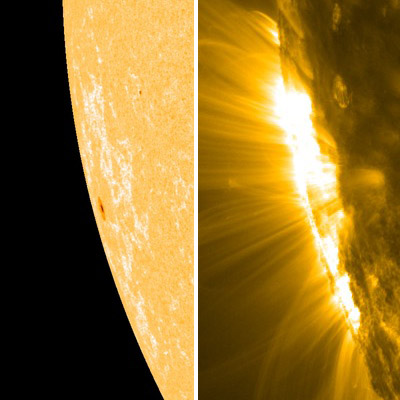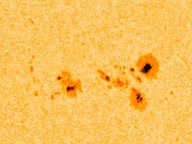Sunspot region 2205, return of 2192, auroral activity
Wednesday, 12 November 2014 18:11 UTC

Solar activity is low, sunspot region 2205 is in decay and no longer a threat for strong solar flares. We also focus on the return of sunspot region 2192, which was the largest sunspot region in 24 years. What will be left of it? We are also experiencing waning CME effects combined with the effects of a coronal hole high speed stream. Aurorae were seen from many high latitude locations. Our header image was taken in Iceland by Michał Rogoś Photography. Stunning work! Unfortunately, the direction of the IMF is pointing northward right now and geomagnetic conditions are back to quiet conditions.
The return of sunspot region 2192
Old sunspot region 2192 (source of six X-class solar flares) is now rotating into view and it is not looking good. It looks like this once massive sunspot region which grew to became the largest sunspot region in 24 years has decayed to almost a spotless plage. We can see large amounts of faculae now near the SE limb with only one sunspot. It is of course possible that there still are sunspots hiding behind the limb but it really looks like most of this once mighty sunspot region has decayed. If there are more sunspots still behind the limb they should become visible within the next 24 hours. We will keep you updated in case a significant sunspot cluster becomes visible tomorrow.

Sunspot region 2205
Sunspot region 2205 continues to decay and is losing spots, penumbral area and magnetic complexity. This sunspot region which was the source of an X1.6 solar flare on 7 November lost all of it's delta sunspots and is no longer a threat for strong (M or X-class) solar flares.

All the sunspot regions currently on the earth-facing solar disk are unremarkable and unlikely to produce strong solar flares. Solar activity will likely be low (C-class flares at most) for at least the coming three days.
Auroral activity
Auroral activity ranged from quiet conditions to minor G1 geomagnetic storm conditions the past 24 hours as reported by the NOAA SWPC where as the Wing-Kp didn't went further than active (Kp4) geomagnetic conditions. This activity came from waning CME effects combined with coronal hole high speed stream effects. Aurorae were seen from many high latitude locations. Our header image was taken in Iceland by Michał Rogoś Photography. Stunning work!
The solar wind speed remains above average right now at 550km/s but the direction of the IMF is pointing northward right now and geomagnetic conditions are back to quiet conditions. Geomagnetic conditions will likely remain quiet with the direction of the IMF pointing northwards and geomagnetic storming is unlikely, even if the direction of the IMF would turn southward.
There are currently no coronal mass ejections on the way to Earth or any coronal holes facing Earth. There is however a large nothern hemisphere coronal hole rotating slowly towards the central meridian but it will still take at least 6 days before we see any effects from it near Earth.

Images: NASA SDO and Michał Rogoś Photography.
Thank you for reading this article! Did you have any trouble with the technical terms used in this article? Our help section is the place to be where you can find in-depth articles, a FAQ and a list with common abbreviations. Still puzzled? Just post on our forum where we will help you the best we can!
Latest news
Latest forum messages
Support SpaceWeatherLive.com!
A lot of people come to SpaceWeatherLive to follow the Sun's activity or if there is aurora to be seen, but with more traffic comes higher server costs. Consider a donation if you enjoy SpaceWeatherLive so we can keep the website online!

Space weather facts
| Last X-flare | 2024/12/08 | X2.2 |
| Last M-flare | 2024/12/22 | M1.1 |
| Last geomagnetic storm | 2024/12/17 | Kp5+ (G1) |
| Spotless days | |
|---|---|
| Last spotless day | 2022/06/08 |
| Monthly mean Sunspot Number | |
|---|---|
| November 2024 | 152.5 -13.9 |
| December 2024 | 103.3 -49.2 |
| Last 30 days | 114 -43.9 |


